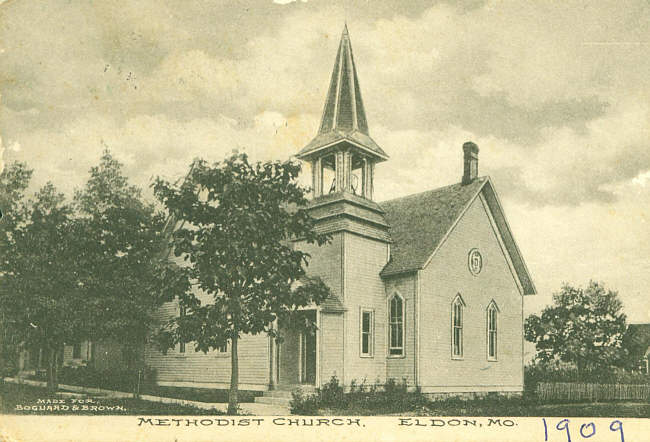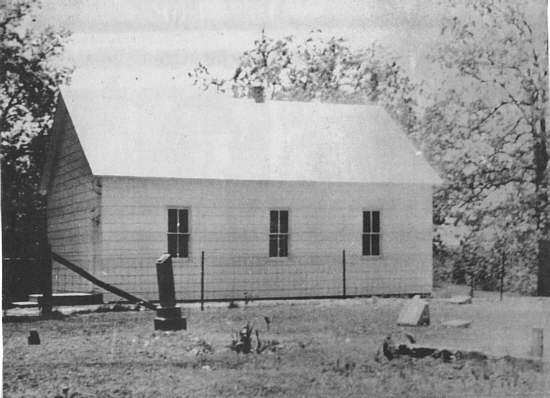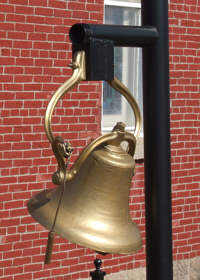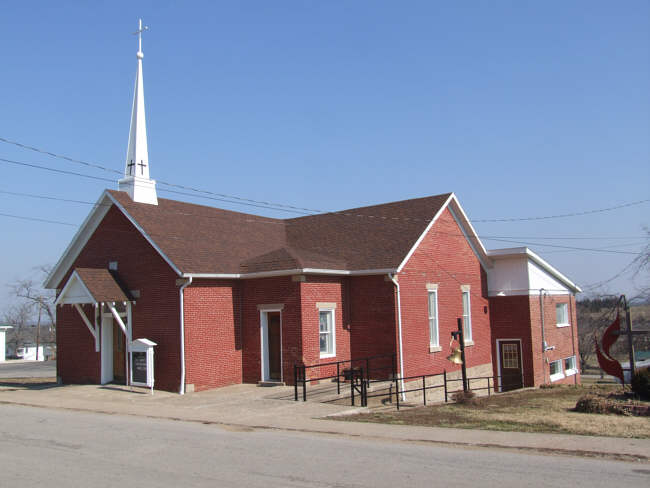|

Churches of Miller County
The Methodist Church
ELDON UNITED METHODIST CHURCH
Compiled by a committee from St. Paul's School of Theology, 1982
 Eldon Methodist Church 1909 The history of the Eldon United Methodist Church must begin with a history of the Methodist Church in Miller County. "The Methodists were early active in this area, with Rev. Brashears preaching to the inhabitants in 1833. The Methodist Church established circuits for ministers, with Reverends Abraham Castleman, John Monroe, John D. Reed, and David Henderson early Circuit Riders." (Judge Jenkins' History of Miller County, pg. 261.) The Methodists sent Rev. Brashears into this region soon after the pioneer Baptists and services were held at Pleasant Mount.
Pleasant Mount (Mount Pleasant), just four miles from the present town of Eldon, was a prosperous trading center long before Eldon was established. Two roads led from the Osage River and the Missouri River. At Mount Pleasant the roads branched, one headed toward California and the other going to Versailles. The California gold rush brought many people going toward California and many returning from California. The town boasted a physician, four taverns, a lawyer, blacksmith, three-story grist mill, and several homes. Both Pleasant Mount and Mount Pleasant appear in many records. When the post office was established the name Pleasant Mount was used. Later the name was changed to Mount Pleasant.
In all probability the preaching in Pleasant Mount gave rise to the spread of the Methodist Church to Olean, east of Eldon, and to High Point, north of Eldon. Records show that Eldon, Olean and High Point were on the same circuit for several years.
There were very few church buildings in the county in the early days of its history. Services were held at schoolhouses, in homes, under the trees, and in brush arbors. The pioneer ministers traveled on horseback or on foot to fill their appointments. Because of their very small salaries most of them were obliged to follow some other line of work in addition to their ministry in order to make a living.
The first church house in the territory, afterward Miller County, was the Smyrna log building in the Big Richwoods (Iberia), near the Henderson Settlement. It was erected by Methodists in 1834. Hite's Chapel, another early Methodist Church, was situated on the Hite Plantation in Saline Township.
In 1841 Rev. John Monroe organized a Methodist Church at Mount Pleasant. William P. Dixon, Claiborn Still, Joseph Sullivan, William Ragsdal1, A. M. Smith, John Sons, and John T. Davis were the first board of trustees. Church was held in the homes of Methodist brethren, especially the Dressers', Dixons' and Smiths'.
With characteristic zeal the Methodist Episcopal Church involved its ministers and membership in the abolition movement. When a temporizing course was adopted allowing congregations, or circuits, to vote on the question, the Church divided into two factions: The Northern against slavery, the Southern for slavery. In conference at Smyrna in 1846 the Methodists in Miller County voted unanimous1y for allegiance to the Methodist Episcopal Church, South.
In the late 1850's the Smyrna congregation in the Big Richwoods, torn apart by the slavery question, reorganized. The new congregation purchased two acres of land from James R. Green, and two acres of land from David and Anna Shelton, in Section 1, Township 39N, Range 12W, "together with all and singular the houses, woods, waterways, privileges and appurtenances thereto" to be held in trust by named trustees and the successors in office forever.
It was stipulated the trustees "shall erect and build or cause to be erected and bui1t a house or place of worship for the use of the members of the Methodist Episcopal Church South, according to the rules and disciplines which from time to time may be agreed upon, and accepted by the ministers and preachers of the said church, at their general conferences; and in further trust and confidence that they shall at all time forever hereafter permit said ministers and preachers belonging to the said church as shall from time to time be duly authorized by the general conference of the ministers and preachers of the said Methodist Episcopal Church South, or by the annual conference, authorized by the general conference, to preach and expand God's holy word therein."
"In 1858 the Methodists built a church house and parsonage of logs in Pleasant Mount, the buildings costing more than $700.00. The Rev. John D. Reed, a Methodist preacher active in this work, died in his home in Pleasant Mount on January 1, 1864. He was buried with Masonic honors."
The sending of abolitionist preachers into Central Missouri by the Methodist Episcopal Church, the great upheaval and division of the church over slavery, shattered Methodism in Miller County. The Methodist Church building at Tuscumbia, housing a saloon during the Civil War, was later destroyed by fire. In 1866 the trustees sold the Methodist Church house, parsonage and grounds at Mount Pleasant to private interests. Eventually Hite's Chapel ceased to exist, and the Smyrna congregation, moving into Maries County, embraced another denomination.
The southern branch of the church had a few missions on the Boonville and Russellville Circuits. Aurora, of the former, and Flatwoods of the latter, are the most important. Aurora Mission had eighteen members, and was formed in 1882 by Rev. J. C. Cass. There was no building. Flatwoods Church had forty members and a frame church valued at $800.00. It was formed in 1887 by Rev. J. L. Sullens with the Palmers, Cha11as, Mrs. M. V. Hauenstein and Mrs. E. A. McGee. Revs. Sullens and Lewis were the pastors.
The northern branch had congregations at Eldon, Olean, Iberia, and a few other missions. They belonged to High Point and Iberia Circuits of Lebanon District, St. Louis Conference. The Eldon Church had about fifty members. It was formed in 1882 by Rev. Brough, who was followed in his pastorate by Revs. Gardenhire, Toland, Jones, and Babbitt.
In the surrounding area, Olean church began its existence in May 1881 with thirteen members. By 1889 there were twenty-one members, but no building. A class was organized two miles south of Rocky Mount in 1888 by Rev. Jones with thirty-nine members and no building. Iberia church received its first preacher in 1867: Rev. R. R. Witen. In 1871 a church was built by J. C. Jamison at a cost of $1,000. The Blantons, Bennages, and Tallma.ns were among the first members. By 1889 membership had increased to 84. Revs. Witen, Threlfall, Dodd, Cowden, Darby, Hanson, Clark, Boyce, Graves, Ramsey and Stickney were among the early pastors.
After the church at Eldon was organized a building was begun at the corner of what was then Fourth and S. Grand Streets. .For reasons unknown the building was not completed until 1883 by the Congregational Church with the help of contributions from other denominations. This building was then rented by the Methodists and Disciples one Sunday per month for one dollar, plus lights and fuel furnished by the renters. There was a union Sunday school held here. It is thought that the steps attached to the residence at 601 South Grand Street were originally part of this church.
In 1889 a new church was built at the corner of Oak and North Streets. It was the northernmost building in Eldon. Mr. W. M. Graham, grandfather of Bess, Jennie, Elmer, Helen, Catherine and George Austin, helped to organize the new church. Richard Boyce, grandfather of Lillian White Jackson, Lois White Slinkman, Boyce White, Hanson White and Joseph White, worked as a carpenter on the building, a white frame construction. This was done during the pastorate of Rev. H. A. Babbit and dedicated one year later under the pastorate of Rev. J. W. Finley. Six years after its construction the church building was destroyed by a cyclone. Still under the pastorate of Rev. Finley a new church building was dedicated June 3, 1900. A revival was held under the ministry of Miss Berdie Crow. Thirty-five were converted.
During the ministry of Rev. C. F. Tippin, 1901-1905, one room was added to the parsonage. Electric lights were installed in the church and parsonage. Also a closet was added to the parsonage and the sitting room papered. Book racks were added to the seats in the church.
On May 11, 1907, Eldon became a station, breaking away from the High Point and Olean Circuit. High Point and Olean joined with Barnett and Rocky Mount and Eldon joined with West Aurora. A sidewalk was added to the church building at this time at a cost of $105.75. The pastor's annual salary was $550 plus $50 for West Aurora.
Among the earliest recorded marriages within the church or performed by the current pastor are: J. Oliver Leaver to Jennie Lowd1e November 6, 1884 by Rev. H. A. Toland; Edward Ralls to Susie M. Burlingame February 25, 1885; J. Ernest wieneke to Sallie W. MCCann October 12, 1892 at a fee of $5.00. Sol'J!'!'On Yates married Hattie L. Brouse November 17, 1892 and paid the minister $2.15 -- "all he had." Among early baptisms the earliest recorded is Arthur Decker on August 27, 1884, an adult; his parents were Francis and Caroline Decker. The place of baptism was given as being "near Proctor" which may mean that some of the earlier baptisms were not done in the church but at local streams, etc.
In the very early days of the Methodist Church in this area and in Miller County, each year the pastor would receive a "church barrel". This came from St. Louis, arriving by rail on the old Missouri Pacific rail lines at West Aurora. The "church barrel" contained clothes and other paraphernalia to be given by the church to people in the area.
The splits in the Methodist Church over slavery resulted in many changes. In 1939, during the ministry of Rev. Raymond Gilbreath (1931-1939), the splits in the church in 1830 and 1844 were healed and the Methodist Episcopal (our church) and the Methodist Episcopal South became the Methodist Church. The reorganization caused many changes in our church. The Ladies Aid Society became the Women's Society of Christian Service. Men's organizations took new names.
In 1968 the united Brethren Church (German speaking Methodists) merged, to become the United Methodist Church. The Women's Society of Christian Service became the United Methodist Women.
In 1924 during the pastorate of Rev. C. F. Green, the church building was remodeled and stucco was placed on the exterior. In 1950 under the guidance of Rev. J. Arthur Brown a new educational building was constructed at a cost of $22,000. In that same year Bishop Ivan Lee Holt of the St. Louis Conference consecrated the new educational building and the new church chancel.
In 1960 there was available a plot of land at the corner of Oak and Fairview Streets which the church board and Rev. James Culpepper thought it wise to purchase for a future site of a new church building. The idea for a new building came as the members realized that the building on Oak and North was old and short on space. Rev. Harold Dodds, with his tremendous personality and organizational skills, was the minister present to see the new church become a reality. While no exact figure was learned as to the actual cost of the new structure, estimates were given from $125,000 to $200,000. Curtiss-Manes Construction Company was the builder and major contractor. The Curtisses donated the tower located near the church in memory of Pearl Curtiss' husband and father of Joe Curtiss and Mabel Manes.
In September 1962 construction was begun on the church and educational buildings. Howard Hebel served as chairman of the building committee. One year later, September 1963, Bishop Eugene M. Frank assisted by Herman Lehwald, Superintendent of the Jefferson City District, and Harold Dodds, pastor of the church, consecrated the new building.
IBERIA METHODIST CHURCH
Reprinted from the 1975 Bicentennial edition of the Miller County Autogram-Sentinel
The Iberia Methodist Church was first a part of the Richwoods Circuit. The first appointment of a preacher was in 1867. The pastor at this time was W.W. Dodd. On March 31, 1879, the Rev. Bayse was appointed to the Iberia-Dixon Circuit and other classes were added. Rev. John Clark was appointed April 13, 1882, and during this year 80 people were added to the church roll.
During the year of 1885 the church was dedicated. In 1893 Rev. Barnes was sent to Iberia. In two months the congregation had grown too large for the small church. The first new church was constructed in another part of town in 1904. Later the present church was built. The land was given to the church by John Ferguson and the bricks were made by some of the members.
The trustees of the present church were John Hopkins, John Ferguson, John C. Thompson and Jerry Whalen. Today, the bricks are the originals but they have been cleaned and re-mortared. Class rooms and stained glass windows have been added along with other remodeling. The Senior Pastor is currently Rev. Ron Orr. Lay Leader is Wayne Vaughan and Organist Eva Jo Grady.
THE CURRY CHURCH
by Mrs. Ernest Rennaker
This is written of the Curry Church-when, how and where.
 Curry Church Church was held at first, before the Curry church was built, in the Curry schoolhouse. Chester Wall, as I'm told, attended a revival in the Madden Church, came home and said, "We'll have to have a church built here." The neighbors met at the store of Grandpa Jim Wall, better known as "Blackie" Wall. That night they decided to build a church some time in the future.
Bro. Curry was then preaching at the schoolhouse and he picked out the spot for the church and cemetery. Bill Clark owned the land, and he gave the deed and donated one acre of ground for the church and cemetery. The leaders were Silas Curry for whom the church was named, Jim Wall, Albert Meredith, Ben Meredith, Frank Wall, Peach Wall, and W.C. Wall.
The ground was measured off and the cemetery site was cleared and a road built to it. That was in about 1896. The first ones buried there were Ella (Curry) Wall, Frank Wall's first wife, and her parents and baby. Ella died May 1, 1896. Silas Curry also died in 1896.
The church wasn't built until several years later, in 1907 or 1908. The lumber and materials were hauled from Crocker by horse and wagon. It was built by donations and by contributed labor. It seems as though Jim Wall and Peach Wall were the largest donators. Albert Meredith, Jim Wall and Frank Wall were appointed trustees. Mathias Meredith made the seats and altar. The first service was preached by the Rev. Mr. Sally, June 1, 1908, with 38 members.
I have no further record from that time until Feb. 1, 1920. The preacher at that time was C.M. Licklider with 58 members. The names, as follows of the first people were immersed in baptism: Bertha (Wall) Condra, Alice (Wall) Payne, May Allee, (they cut the ice in a pond to baptize Bertha and Alice Wall), Jim (Blackie) Wall who died Aug. 3, 1921 and Mildred B. Wall (wife) who died July 28, 1921, Otis Wall, Jane Wall (deceased) Everett Wall, Lucy Wall, Charley Long, Ella Long, Lou Wines, Zee (Wall) Woolford, W.H. Wall, Stella Wall, Goldie Wall, Clyde Wall, Cora May Wall, Raymond Wall, W.C. Wall, Sallie Wall (his wife), Bernice Wall, Mary Ella Wall, Maude Wall, Grace Wall, Edith Wall, F. Wall, Sarah Wall, Pearl Wall, Oma Wall, Chester Wall, Della Wall, Jesse Wall, Effie (his wife), Gladys Wall, N.D. Martin, Minnie Martin (his wife), Frank Martin, Lillie Martin (his wife), Zella Thornsberry, Millie Duncan, Cora Miller, Clara Miller, May Allee, Ollie Miles, Harry Long, Cecil Long, Ralph Long, Barney Hutsler, Eunice Hutsler, King Shackleford, Harry Wall, Eunice Wines, Minnie Wall, Maudie Meredith, J. A. Meredith, Stella Workman, Jessie Shackleford, Fern Martin, Maudie (Meredith) Shelton. The record is so blurred I may have made some mistake in the first names.
There were several preachers who preached from 1908 to 1939. Some of those were Brodric Hale, Buckner Boyer, Sally, and Erickson. The Rev. Mr. Rude was the last Methodist preacher to preach. Then Kelly, Silax, Sister Rose, Scott. A Baptist preacher from Iberia held a revival, David Drace preached a few sermons, also Bate held church services for a length of time. I am sorry if I have missed anyone.
In 1939 the Sunshine Club was organized, 16 members with Mrs. Genevieve Rennaker Secretary and Treasurer.
As the fence was down, stock was knocking over tombstones. The cemetery had grown up in high grass and brush. We decided to do something about it. We bought woven wire and steel posts, grubbed out the brush; we put in new windows and painted the roof and the church inside and out, and added cement steps, and new doors and lights. This was done by the men of the community. They also cleared out the ground between the church and road. In 1970 the church had slipped off the rocks on the south side and the building was leaning and splitting so again it was decided to do something about it.
Much credit goes to Mrs. Gladys Duncan, and Mrs. Lola Allee for their time in taking up donations, and will say "God bless them," and those who so generously donated to this cause and to the men who donated their work and time. Now we have a new church throughout, except frame work and roof.
We are looking forward on hearing the Rev. Earl Brown preach the memorial service and the dedication of this new church. We are going to have a basket dinner on that day, May 28.
SHORT HISTORY OF THE CURRY CHURCH
by Peggy Smith Hake
In 1896, William J. and Sarah A. Clark of Miller County sold two acres of land to the Trustees of the Methodist Episcopal Church. The trustees named were J. M. Wall, Silas H. Curry, Frank Wall, Benjamin Meredith, and J. A. Meredith.
This Methodist church was listed as the Methodist Episcopal Church, south of the Decaterville Circuit. The location was in southern Richwoods Township in the Northeast quarter of the Northeast quarter of Section 7, Township 38, Range 13 of Miller County.
The old church still stands today in the same location; it has been remodeled used at different times by various congregations. There is a graveyard to the side of the building with many old gravestones standing and has always been well-kept. Over the years it has been called Curry Church and was situated near the old settlement and post office in southern Miller County called Faith.
|
|






